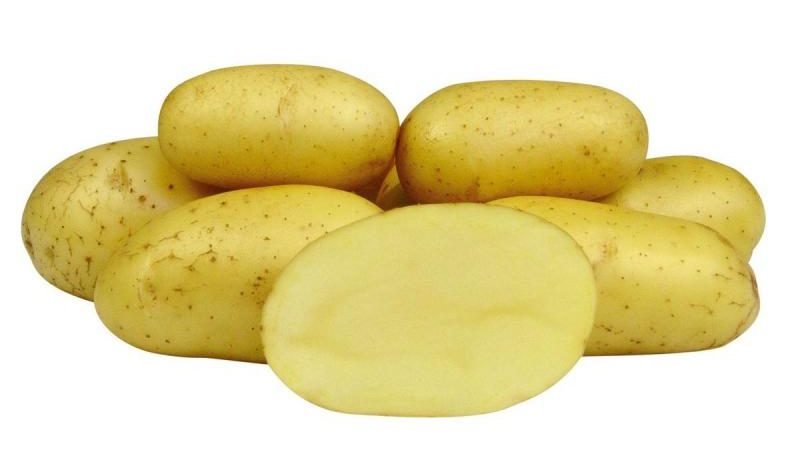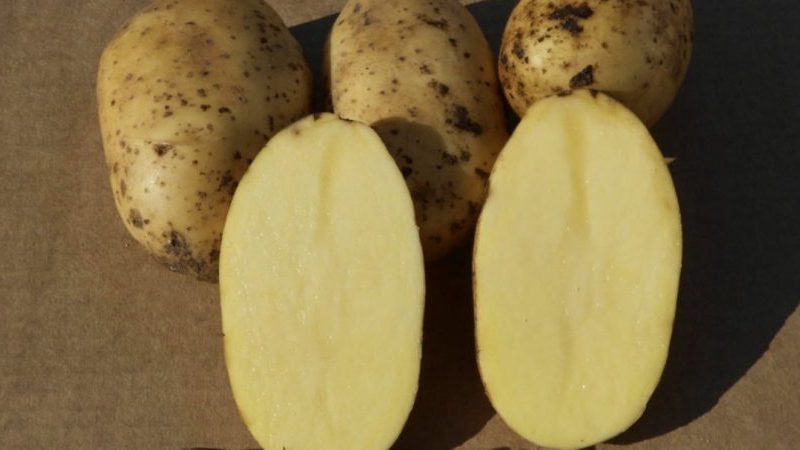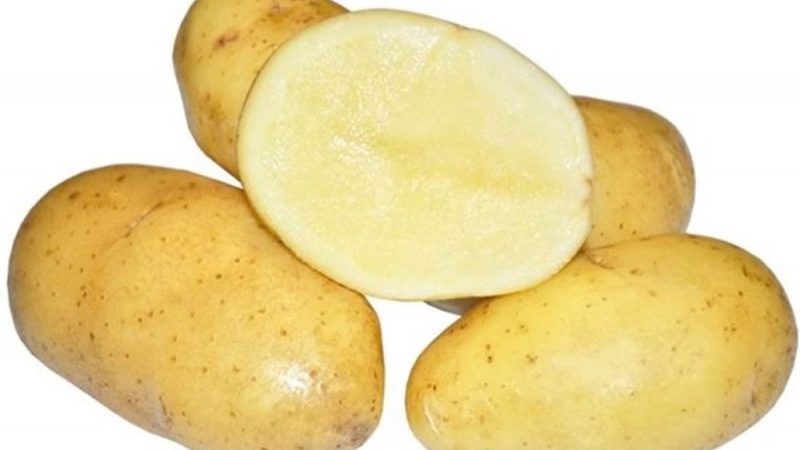Early ripe table potato variety "Colette", which bears fruit twice a season
Colette potatoes, which are grown in large farms and in small subsidiary plots, are very popular in our country. The main advantage of the variety is that it gives 2 harvests per season.
The content of the article
Description of the variety
Colette has a fast germination, high productivity, excellent keeping quality, good marketability and taste. Unpretentious in care, resistant to pests and diseases, versatile in cooking.
The table potato variety Colette was developed by German breeders in the late 90s. It is mainly grown for the production of chips and fries.

Other distinctive features of the Colette variety:
- amicable maturation;
- long-term storage;
- transportability;
- low susceptibility to nematodes.
Chemical composition, vitamins and trace elements
Colette contains a large amount of vitamins, trace elements and amino acids. It is beneficial for bone structure, digestive system and metabolism. This potato variety contains folic acid, which prevents the formation of cancer cells, as well as potassium and vitamins C and B6, which are beneficial for the cardiovascular system.
Attention! Because of its high potassium content, potatoes are contraindicated in people with kidney disease.
The flavonoid quercetin contained in the composition protects cells from free radicals. Colette potatoes improve skin condition and promote the disappearance of wrinkles.
Colette potato characteristic, productivity
Colette tubers are approximately the same size and oval, elongated. The mass of one potato averages 130 g, the color of the flesh is pale yellow. The starch content is below the norm - only 12-18%. The peel is smooth, bright yellow, the eyes are weak.
From one bush, 6 to 11 tubers are harvested. The plus is that they are located close to the surface, it makes digging easier. Average yield - 166-217 kg / ha. The maximum yield was noted in the Rostov region - 290 c / ha.
Some sources claim that with proper agricultural technology, up to 600 c / ha can be harvested. At the same time, the high marketability of tubers remains - 76-98%.
Growing regions and planting dates
Despite the fact that the Colette variety was included in the State Register of Russia for cultivation in the Central, Volgo-Vyatka and North Caucasian regions, it is grown almost everywhere in our country, as well as in Moldova and Ukraine. It grows well in regions with cool, humid summers.
In the south of the country, Colette is planted in late April - early May, in the central and northern regions - from mid to late May. By the time of planting, the soil should be sufficiently moistened and warmed up. The threat of frost must be completely avoided. Planting too early or too late reduces yields.
Advantages and disadvantages of the variety
Colette potatoes have a number of advantages:
- the ability to grow two crops per season;
- excellent taste;
- fast germination;
- high productivity;
- disease resistance;
- long-term storage.
Among the disadvantages of the Colette variety, its susceptibility to late blight is distinguished. However, preventive measures can successfully cope with this disease.
Features of planting and growing
The Colette variety is early maturing and ripens 60-75 days after planting, which allows you to harvest two crops per season. Many gardeners recommend co-cultivation. Colette potatoes, for example, grow well with beans. They scare away pests from each other and give a more bountiful harvest than separately.
Training
Before planting, the seed is treated with drugs to stimulate growth and protect against diseases and pests. These are "Prestige", "Cruiser", "Albit", "Force" and others. Sprouting and warming up accelerates germination and increases the yield of the Colette.
Only healthy tubers are taken for germination. They are placed in boxes and sprinkled with humus, and on top they are watered with Gumi fertilizer. The top layer is covered with compost and covered with foil. The boxes are left in a dark, warm place for germination.
Landing scheme and technology
Tubers are best planted in rows with a row spacing of 75 cm and a plant spacing of 30 cm. The planting depth of the planting material may differ on different soil types. On light soils, holes are made up to 10 cm deep, on heavy soils - no more than 6 cm.
Reference. It is recommended to put tubers in the holes with the sprouts down. Thanks to this simple technique, the bush will grow large and spreading and bring a bountiful harvest.
When planting sprouted potatoes, ash and humus are poured into the holes. In this case, you can leave not 30, but only 25 cm between the bushes.
Growing features

To get a high and amicable harvest, you need the right agricultural technology. Therefore it is important:
- Compliance with crop rotation. A good harvest will be after legumes, cucumber, zucchini, cabbage, garlic, onions, siderates.
- The right choice of soil. Loose fertile soils (light loam and sandy loam) are best suited.
- Regular moisturizing and weeding.
- Timely renewal of seed material.
The nuances of care
Hilling is carried out 2-3 times per season. The first time - after the appearance of 2-4 leaves. They will completely hide underground, which will protect even weak and delicate shoots from the effects of low temperatures at night. The next 1-2 hilling is carried out before the potatoes bloom, with a difference of 2 weeks.
Weed and loosen the soil as weeds appear. The first loosening is before the emergence of shoots, no deeper than 1-1.5 cm, otherwise the potato sprouts will be damaged. It is convenient to combine the following loosening procedures with hilling bushes.
Watering mode
Watering is carried out if there is no precipitation. The soil should be moist, but not waterlogged. Colette's yields increase on well-watered soils, making an automatic irrigation system the ideal solution.
Attention! When grown on a subsidiary farm, there may be difficulties with irrigation. Without germination, a long wait for seedlings is possible.
Top dressing
Colette potatoes are fed 3 times a season with Nitrofoska, Solution or Effecton. The first feeding is when the tops are still thin and the leaves are light. The second and third time the potatoes are fed before flowering with an interval of 10-14 days.
Important! Mineral dressings are applied to the soil in standard quantities, and nitrogen fertilizers are applied in limited quantities. This is due to the fact that an excess of nitrogen leads to active growth of tops, not tubers.
From organic fertilizers, it is recommended to apply bird droppings in a ratio of 1:15 to water. The resulting solution is infused for 2 days in a warm place, then introduced into moist soil. This should be done only in the evening, without touching the foliage, so as not to burn the plants. 1 bush accounts for 1 liter of fertilizer.
Wood ash can be used in the following ways:
- In the form of top dressing. 2 tbsp. l. ash is brought under each bush at the first hilling and 50 g at the second hilling.
- For the prevention of late blight. Plants are pollinated with ash in wet weather 2-3 times during the flowering period, 15 g per bush.
Disease and pest control
Variety Colette is resistant to golden cyst nematode, cancer causative agent, viruses A and Y, common scab, black leg. Has an average resistance to leaf curling.
Susceptible to late blight by tops and tubers is the main drawback of the variety. To solve the problem, it is important to carry out preventive treatments with the drugs "Ditan M-45", "Kuproksat" and observe crop rotation.
Harvesting and storage
With proper care, the first crop of potatoes is harvested at the end of June - mid-July, depending on the region. Drying tops serves as a signal to start harvesting. The bushes are dug out by hand or using special equipment.
Attention! When harvesting, it is important not to damage the thin skin of the tubers. Tubers with mechanical damage are poorly stored, lose their presentation, and sometimes taste.
After harvesting, the soil is weeded, cultivated and watered. Then they start again landing... The care measures are the same as when growing the first crop. The second time the potatoes are dug up around September.
The tubers are harvested in clear, dry weather and left on a flat surface to dry for several days. The crop is sorted out, removing damaged and diseased tubers. Healthy potatoes weighing 50-80 g are selected for planting. After that, all the rest of the potatoes are lowered into the basement for storage.
Storage features and keeping quality of the variety
Colette potatoes can be stored well for a year after harvesting and are not damaged during transportation. Keeping quality is 92%. Germination tendency is low. The storage room should be well ventilated and at a temperature of about + 3 ° C.
Tips from experienced gardeners and reviews about the Colette variety
Unsurprisingly, the Colette potato variety has received overwhelmingly positive reviews. Here are just a few of them.

Tatiana, Izhevsk: «Collet's potatoes happened to be with us. It's just that one farmer owed money for herbicides; instead, he brought potatoes. We planted it in early May. I advise everyone to plant it in moist soil so that it is easier for the potatoes to come to life and take root. The harvest was dug at the end of August. The tubers are oval, very good in appearance, the yield is not very high, but within the normal range. The potato is yellow on the outside and in section. The taste is one of the best I have ever tasted! It is great for mashed potatoes, frying and cooking soups. Very soft, but not soft. Colette is stored until next summer without any problems at all. Recommend".
Olga, Tomsk: “We bought Colette potato seeds in one of the large chain stores. A package weighing 2 kg cost about 139 rubles. All planting material was very good, as in the photo and in the description of the Colette potato variety on the package. They planted it shallow on April 30, huddled, dug up in early August. The land on the site is fertile, so we didn't fertilize it with anything on purpose. Harvested about one bucket of 10 liters from 8 bushes. On the bushes there were large and very small tubers, there were no giant ones. A total of 4.5 ten-liter buckets were collected, the yield did not strike exactly. I liked the look very much. For cooking and mashed potatoes have a very mediocre taste, like "soapy", but they do not boil down even after a very long cooking. But these potatoes turned out to be very tasty when fried. It's not for nothing that it's grown for chips and fries. "
Read also:
Medium early high-yielding potato variety "Belmondo".
Ideal potato variety for winter purchase: Jelly.
Young but promising German potato variety "Krona": description and reviews.
Conclusion
The Colette variety gives a high yield of potatoes with just a few simple rules. This is the correct choice of the predecessor and type of soil, germination before planting, traditional care. Then Colette pleases not only with the excellent taste of the tubers, but also with a consistently high yield.